 This article appears in the Summer 2024 issue
This article appears in the Summer 2024 issue

Rethinking Weeds:
You won’t find these plants at your local nursery
“What’s in a name? That which we call a rose
By any other name would smell as sweet.”
—William Shakespeare
Any number of dictionaries refer to the word “weed” using distasteful associations. For example, you “weed out” troublesome things or people that are “useless or harmful.” If you’re a plant, the name “weed” makes you clearly undesirable and ascribes attributes such as “kills desirable plants,” “invasive,” “prevents desirable plants from growing properly.”
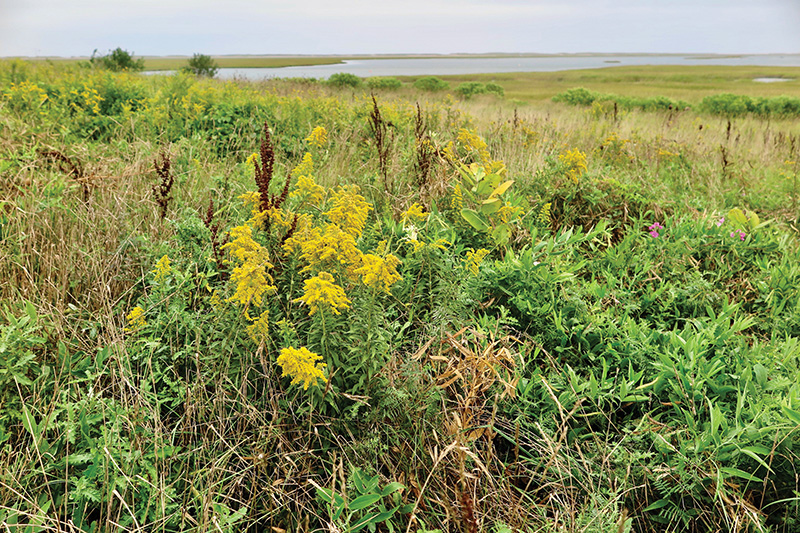
Common “weedy species” pictured here, including goldenrod and curly dock (the dark spires), are essential to our wild landscapes, and some even deserve a space in our backyard gardens.
These attributes can be true, but a more useful definition for weed is a plant considered undesirable or otherwise unwanted in a particular situation. Especially for agriculture and more recently for the maintenance of lawns, entire volumes have been devoted to the identification and means for removal of these maligned species.
But a weed, by any other name, can also be an important source of nutrients and sustenance for human health, produce flowers and seeds that support wildlife habitats, and even provide humans with keys to climate change adaptation. Here are a few weeds for your reconsideration.
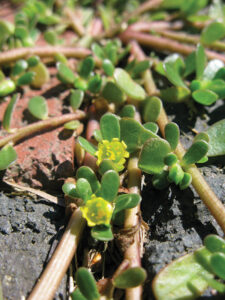
The lowly purslane has some surprising attributes as a health food.
Purslane (Portulaca oleracea)
Several years ago, I happened upon an elderly couple of Asian descent pulling weeds from a plot of stripped land that formerly was the site of a restaurant in Old Saybrook, Connecticut. They were filling white plastic grocery bags with a low-growing plant that appeared to be thriving on this otherwise barren site. A young woman, perhaps a granddaughter, was standing at a distance looking askance at the activity. I approached her to ask why they were collecting the plant, to which she replied, “They use them as a green in soup.” When I made eye contact with the man, he smiled and pointed to the abundance in his bag.
The plant was purslane, a common weed that grows in disturbed places. It expands outward from a central taproot, close to the ground, with succulent, bright green leaves and small yellow flowers. It is one of the hearty weeds that is surprisingly common (with, in fact, a worldwide distribution), and largely overlooked. Also known as wild portulaca, purslane resembles a smaller and less showy version of the common annual flower sold at local garden centers.
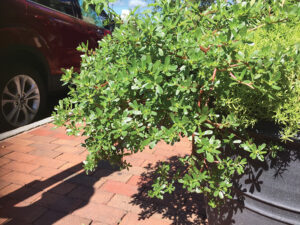
I was surprised and delighted to find purslane being used ornamentally in a streetscape potted flower arrangement.
What makes this plant interesting is its outstanding usefulness as a healthy, eminently eatable herb—listed by the World Health Organization as one of the most useful medicinal plants in the world. Its protein and mineral content is notable. It has been shown to contain five times more omega-3 fatty acids (important for maintenance of a healthy immune system) than spinach, and it has antibacterial properties that make it useful in a poultice for cuts and burns.
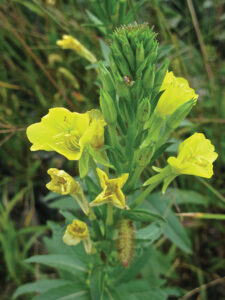
The attractive wild type of the common weed evening primrose doesn’t ask for much and provides great resources for pollinators.
Evening Primrose (Oenothera biennis)
A North American native, evening primrose is a tall flowering plant commonly found blooming in late summer along the tough, droughty, and nutrient-poor borders of our roads and highways. It is most noticeable when its bright yellow flowers surround a single, tall, semi-woody stem, which appears in the second year of this plant’s development.
As its name suggests, the flowers of the evening primrose bloom in late afternoon and evening. Shortly before sunset the petals will slowly unfurl, a phenomenon that you can actually observe over a five-to-ten-minute period. The blooms will last throughout the night and diminish by the following noon. Their early evening and nighttime flowering provides an opportunity to observe the charismatic sphinx moths—thought to be the primary pollinators of this plant.
This durable and lesser-known plant provides resources for a number of pollinators, including a species of native sweat bee that relies on it, and visiting bumblebees, honeybees, and several other native bees. Several moth species rely on the flower buds and foliage of the evening primrose, especially in the caterpillar stage, including the primrose moth (Schinia florida) that dons striking pink wings, and can only eat the flower buds of plants in the genus Oenothera.
True to its “weed” status, this plant is a prolific seed producer which benefits many birds. Late summer goldfinches will work their way up and down seed stalks to feast on the proffered bounty.
This plant’s capacity for self-seeding is legion—which is great for the wildlife that relies on it, but less so within the context of our suburban landscapes. Extra seedlings can be readily pulled, and a super abundance of developing seedpods can easily be removed to keep this plant in check.
Pokeweed (Phytolacca Americana)
Pokeweed is a traditional southern Appalachian food staple where its leaves are cooked (carefully replacing the water between boiling two or more times to remove natural toxins) and eaten much like spinach. While botanists and medical professionals alike urge caution and do not recommend its consumption, as late as the 1990s it was commercially canned and sold. The leaves are rich in vitamins (A, B12, C, K, and manganese). If leaves and stems are harvested early in the spring and prepared properly, it provides a welcomed fresh green.
The chances are good that if you don’t think that you know this plant, a picture of its showy deep purple berry clusters that sport a striking fuchsia stem will re-familiarize you with it. The name “phytolacca” means red dye plant.
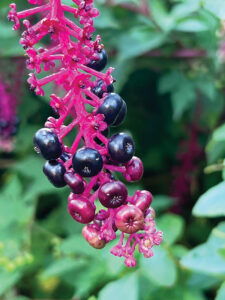
The dramatic colors of the pokeweed fruit are a welcomed sight to many songbirds and other wildlife, and are a striking addition to the summer landscape.
Pokeweed can grow in excess of six feet tall, sporting multiple clusters of dangling, glossy berries that have considerable value to many songbirds, including the cedar waxwing, rose-breasted grosbeak, mourning dove, gray catbird, northern mockingbird, northern flicker, thrushes, robin, and historically, the passenger pigeon. Familiar woodland mammals—grey fox, raccoon, and opossum among them—also seek out pokeweed fruit, while deer prefer the plant’s late summer forage which is said to have as much as thirty-two percent digestible protein.
Pokeweed is easily and effectively spread by the animals that consume its seeds. Although it is an herbaceous perennial that dies back in the fall, below ground it maintains a thick central taproot each winter that can be formidable to remove over time. Because of its value to wildlife (and unintimidated human foragers) and as a component of our local ecology, pokeweed has an important place in our local landscapes. Its presence can be edited to accommodate the needs of both humans and wildlife.
Increasingly, in the search for solutions and adaptations to a changing climate, scientists have turned to weeds to better understand their aggressive ability to adapt. Weeds can offer valuable insights into rapid evolution that could inform crop breeding. The ability to thrive without inputs of fertilizer and the use of pesticides provide a welcomed opportunity to wean our landscapes of these inputs. “Weeds” may be the “winners” in a rapidly warming climate; at the least, their durability ensures the continuation of benefits for both people and wildlife into the future.
Judy Preston is a local ecologist active in the Connecticut River estuary.
